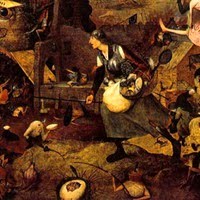| |
Mad Meg
One of the most inventive images of the
Northern Renaissance,
Mad Meg is perhaps the most Bosch-like composition by Bruegel, at least
at first glance. There are monsters, demons, a wild melee of ruins,
ships, weird towers and caves, and conflagrations, whereever you look.
But the resemblance fades somewhat as one observes more closely. First
of all there is the truly predominant figure, the Dulle Griet or
Mad Meg, who is quite alien to Bosch's imagination. She is worse
than Hell itself. In fact, she may have just emerged from Hell victorious,
laden with loot, and ready for other conquests which we can only imagine.
While other, minor hags, crowd the bridge which Mad Meg has just left
behind, in a wild contest for the coins that a Bosch-like monster sitting
on the roof of a house shovels down to them from his behind, Mad Meg strides
on in contemptuous isolation, with the wild stare of the true fanatic
armed for combat, a formidible shrew who has reduced the monsters of Hell
to puny little nincompoops brandishing their armour in pathetically harmless
gestures. She is greed personified, a truly capital sinner and, not unlike
the designs which Bruegel had just previously engraved in The Vices
(1556-57), Mad Meg is a symbol of disaster such as disorder, heresy or
violence.
Sins and Satan
Beside greed, many other sins populate
this Hell. The meaning of some of the monsters, animals, birds, and objects
is just as difficult to identify as it is in paintings by Bosch, but gluttony,
vanity, and unchastity, are more or less clearly characterised. Most impressive
is Bruegel's vision as Satan as an enormous whale-like demon, still reminiscent
of the traditional 'Mouth of Hell' but now conceived as an impassive tool
rather than a violent agent of destruction - so impassive and stupid in
fact that its horrible face and horrified eye have themselves become the
victim of a special brand of parasites. This concept had already been
fully developed in a composition known to us from Bruegel's original drawing
in the Ashmolean Museum, Oxford and from an engraving of 1556 published
by Hieronymus Cock, strangely without Bruegel's name.
The Bosch-like character of the picture
is quite evident from the detail. Its monsters and its magnificent fiery
colour palette
are familiar from the older master's representations of Hell, particularly
of that on the right-hand panel of Bosch's Haywain
Triptych (1500, Prado Museum, Madrid). But Bruegel has endowed
the scene with greater vigour, which while lacking in Bosch's lyrical
charm, produces a level of reality which fits the different character
of the picture to perfection. The more three-dimensional forms of the
buildings and other objects such as the big bowl with the soldiers, the
bell and the flag, the soldiers themselves and the monsters, make them
appear more absurb and more foolish than any of Bosch's, and more appropriate
to the protangonist of the painting, which is, afterall, not Satan but
Mad Meg.
Bruegel belonged to the progressive-minded
intelligentsia of Flanders, and thus his paintings typically contain a
moralistic commentary on social affairs. Here, the allegory of Mad
Meg (Dulle Griet) is believed to have been designed as a comment on
the uncertain political and religious situation in 16th-century Antwerp,
and a warning of what might happen should events get out of control. The
Tower of Babel (1563, Kunsthistorisches Museum, Vienna) was
another work that contained a clear warning of what disasters might befall
Antwerp should its rapid expansion continue unchecked.
Pieter Bruegel the Elder
Bruegel was the most original, inventive
and influential of all Flemish
painters during the 16th century. In addition to apocalyptic imagery,
like Mad Meg (Dulle Griet), he produced a number of innovative
Biblical works - including: Massacre
of the Innocents (1564, Kunsthistorisches Museum, Vienna); The
Census of Bethlehem (1566, Musee des Beaux-Arts, Brussels), and Parable
of the Blind (1568, Museo Nazionale di Capodimonte, Naples) -
landscapes such as the Hunters in
the Snow (c.1565, K.M., Vienna), and genre paintings including
Netherlandish Proverbs
(1559, Gemaldegalerie
SMPK, Berlin), Fight Between Carnival and Lent (1559, K.M.,
Vienna), Children's Games (1560, K.M., Vienna), The Wedding
Dance (1566, Detroit Institute of Arts), The Land of Cockaigne
(1567, Alte Pinakothek, Munich), The Peasant Dance (c.1568, KM,
Vienna), The Peasant Wedding
(c.1567, K.M., Vienna) and The Beggars (1568, Louvre, Paris).
|

